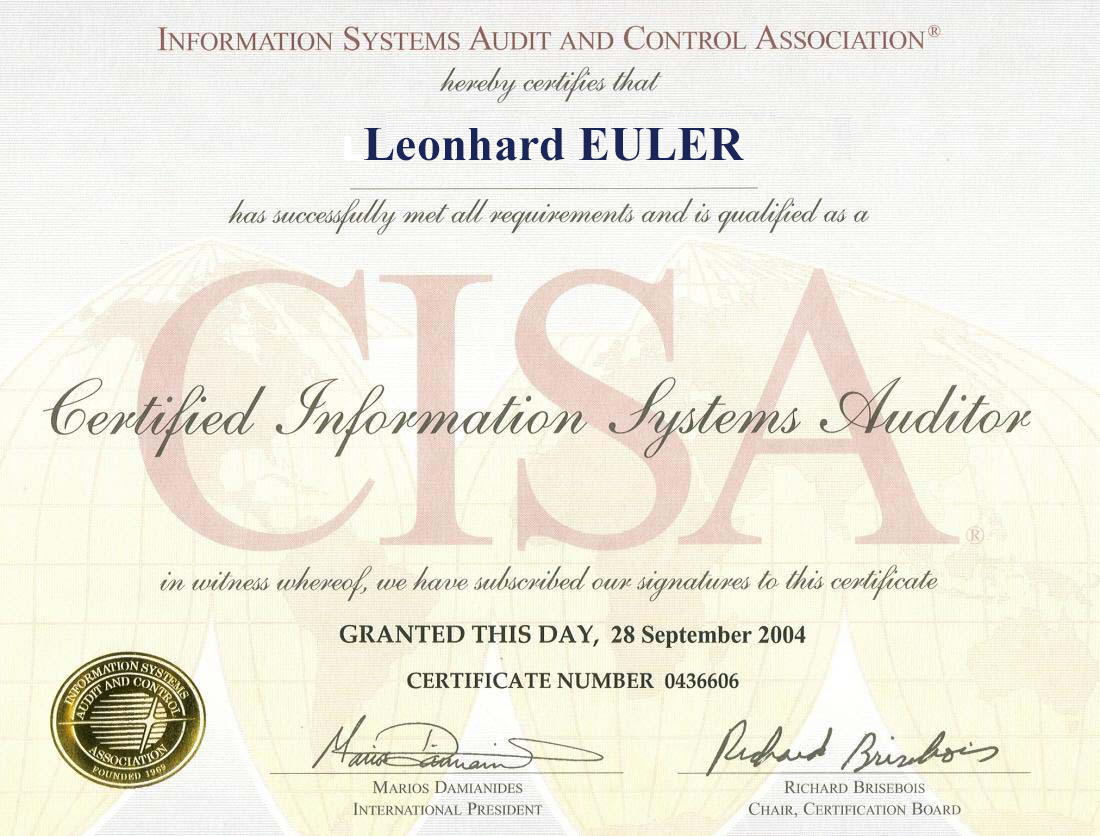- Domain 1 – Information System Auditing Process (18%)
Provide IS audit services in accordance with IS audit standards, guidelines and best practices to assist the organization in ensuring that its information technology and business systems are protected and controlled
Tasks- Develop and implement a risk-based IS audit strategy for the organization in compliance with IS audit standards, guidelines and best practices.
- Plan specific audits to ensure that IT and business systems are protected and controlled.
- Conduct audits in accordance with IS audit standards, guidelines and best practices to meet planned audit objectives.
- Report audit findings and make recommendations to key stakeholders to communicate results and effect change when necessary.
- Conduct follow-ups or prepare status reports to ensure that appropriate actions have been taken by management in a timely manner.
- Knowledge of ISACA IS Auditing Standards, Guidelines and Procedures and the Code of Professional Ethics
- Knowledge of risk assessment concepts, tools and techniques in an audit context
- Knowledge of control objectives and controls related to information systems
- Knowledge of audit planning and audit project management techniques, including follow-up
- Knowledge of fundamental business processes (e.g., purchasing, payroll, accounts payable, accounts receivable) including relevant IT
- Knowledge of applicable laws and regulations that affect the scope, evidence collection and preservation, and frequency of audits
- Knowledge of evidence collection techniques (e.g., observation, inquiry, inspection, interview, data analysis) used to gather, protect and preserve audit evidence
- Knowledge of different sampling methodologies
- Knowledge of reporting and communication techniques (e.g., facilitation, negotiation, conflict resolution, audit report structure)
- Knowledge of audit quality assurance systems and frameworks
- Domain 2 – Governance Assessment and Management of IT (18%)
Provide assurance that the organization has the structure, policies, accountability, mechanisms and monitoring practices in place to achieve the requirements of corporate governance of IT.
Tasks- Evaluate the effectiveness of the IT governance structure to ensure adequate board control over the decisions, directions and performance of IT so that it supports the organization’s strategies and objectives.
- Evaluate the IT organizational structure and human resources (personnel) management to ensure that they support the organization’s strategies and objectives.
- Evaluate the IT strategy and the process for its development, approval, implementation and maintenance to ensure that it supports the organization’s strategies and objectives.
- Evaluate the organization’s IT policies, standards and procedures and the processes for their development, approval, implementation and maintenance to ensure that they support the IT strategy and comply with regulatory and legal requirements.
- Evaluate the adequacy of the quality management system to determine whether it supports the organization’s strategies and objectives in a cost-effective manner.
- Evaluate IT management and monitoring of controls (e.g., continuous monitoring, quality assurance [QA]) for compliance with the organization’s policies, standards and procedures.
- Evaluate IT resource investment, use and allocation practices, including prioritization criteria, for alignment with the organization’s strategies and objectives.
- Evaluate IT contracting strategies and policies, and contract management practices to determine whether they support the organization’s strategies and objectives.
- Evaluate risk management practices to determine whether the organization’s IT-related risks are properly managed.
- Evaluate monitoring and assurance practices to determine whether the board and executive management receive sufficient and timely information about IT performance.
- Evaluate the organization’s business continuity plan to determine the organization’s ability to continue essential business operations during the period of an IT disruption.
- Knowledge of IT governance, management, security and control frameworks, and related standards, guidelines, and practices
- Knowledge of the purpose of IT strategy, policies, standards and procedures for an organization and the essential elements of each
- Knowledge of organizational structure, roles and responsibilities related to IT
- Knowledge of the processes for the development, implementation and maintenance of IT strategy, policies, standards and procedures
- Knowledge of the organization’s technology direction and IT architecture and their implications for setting long-term strategic directions
- Knowledge of relevant laws, regulations and industry standards affecting the organization
- Knowledge of quality management systems
- Knowledge of the use of maturity models
- Knowledge of process optimization techniques
- Knowledge of IT resource investment and allocation practices, including prioritization criteria (e.g., portfolio management, value management, project management)
- Knowledge of IT supplier selection, contract management, relationship management and performance monitoring processes including third-party outsourcing relationships
- Knowledge of enterprise risk management
- Knowledge of practices for monitoring and reporting of IT performance (e.g., balanced scorecards, key performance indicators [KPIs])
- Knowledge of IT human resources (personnel) management practices used to invoke the business continuity plan
- Knowledge of business impact analysis (BIA) related to business continuity planning (BCP)
- Knowledge of the standards and procedures for the development and maintenance of the business continuity plan (BCP) and testing methods
- Domain 3 – Information Systems Acquisition, Development and Implementation (12%)
Provide assurance that the management practices for the development/acquisition, testing, implementation, maintenance and disposal of systems and infrastructure will meet the organization’s objectives.
Tasks- Evaluate the business case for proposed investments in information systems acquisition, development, maintenance and subsequent retirement to determine whether it meets business objectives.
- Evaluate the project management practices and controls to determine whether business requirements are achieved in a cost-effective manner while managing risks to the organization.
- Conduct reviews to determine whether a project is progressing in accordance with project plans, is adequately supported by documentation and status reporting is accurate.
- Evaluate controls for information systems during the requirements, acquisition, development and testing phases for compliance with the organization’s policies, standards, procedures and applicable external requirements.
- Evaluate the readiness of information systems for implementation and migration into production to determine whether project deliverables, controls and the organization’s requirements are met.
- Conduct postimplementation reviews of systems to determine whether project deliverables, controls and the organization’s requirements are met.
- Knowledge of benefits realization practices (e.g., feasibility studies, business cases, total cost of ownership [TCO], ROI)
- Knowledge of project governance mechanisms (e.g., steering committee, project oversight board, project management office)
- Knowledge of project management control frameworks, practices and tools
- Knowledge of risk management practices applied to projects
- Knowledge of IT architecture related to data, applications and technology (e.g., distributed applications, web-based applications, web services, n-tier applications)
- Knowledge of acquisition practices (e.g., evaluation of vendors, vendor management, escrow)
- Knowledge of requirements analysis and management practices (e.g., requirements verification, traceability, gap analysis, vulnerability management, security requirements)
- Knowledge of project success criteria and risks
- Knowledge of control objectives and techniques that ensure the completeness, accuracy, validity and authorization of transactions and data
- Knowledge of system development methodologies and tools, including their strengths and weaknesses (e.g., agile development practices, prototyping, rapid application development [RAD], object-oriented design techniques)
- Knowledge of testing methodologies and practices related to information systems development
- Knowledge of configuration and release management relating to the development of information systems
- Knowledge of system migration and infrastructure deployment practices and data conversion tools, techniques and procedures
- Knowledge of postimplementation review objectives and practices (e.g., project closure, control implementation, benefits realization, performance measurement)
- Domain 4 – Information Systems Operation and Business Resilience (26%)
Provide assurance that the processes for information systems operations, maintenance and support meet the organization’s strategies and objectives.
Tasks- Conduct periodic reviews of information systems to determine whether they continue to meet the organization’s objectives.
- Evaluate service level management practices to determine whether the level of service from internal and external service providers is defined and managed.
- Evaluate third-party management practices to determine whether the levels of controls expected by the organization are being adhered to by the provider.
- Evaluate operations and end-user procedures to determine whether scheduled and nonscheduled processes are managed to completion.
- Evaluate the process of information systems maintenance to determine whether they are controlled effectively and continue to support the organization’s objectives.
- Evaluate data administration practices to determine the integrity and optimization of databases.
- Evaluate the use of capacity and performance monitoring tools and techniques to determine whether IT services meet the organization’s objectives.
- Evaluate problem and incident management practices to determine whether incidents, problems or errors are recorded, analyzed and resolved in a timely manner.
- Evaluate change, configuration and release management practices to determine whether scheduled and nonscheduled changes made to the organization’s production environment are adequately controlled and documented.
- Evaluate the adequacy of backup and restore provisions to determine the availability of information required to resume processing.
- Evaluate the organization’s disaster recovery plan to determine whether it enables the recovery of IT processing capabilities in the event of a disaster.
- Knowledge of service level management practices and the components within a service level agreement
- Knowledge of techniques for monitoring third-party compliance with the organization’s internal controls
- Knowledge of operations and end-user procedures for managing scheduled and nonscheduled processes
- Knowledge of the technology concepts related to hardware and network components, system software, and database management systems
- Knowledge of control techniques that ensure the integrity of system interfaces
- Knowledge of software licensing and inventory practices
- Knowledge of system resiliency tools and techniques (e.g., fault tolerant hardware, elimination of single point of failure, clustering)
- Knowledge of database administration practices
- Knowledge of capacity planning and related monitoring tools and techniques
- Knowledge of systems performance monitoring processes, tools and techniques (e.g., network analyzers, system utilization reports, load balancing)
- Knowledge of problem and incident management practices (e.g., help desk, escalation procedures, tracking)
- Knowledge of processes for managing scheduled and nonscheduled changes to the production systems and/or infrastructure including change, configuration, release and patch management practices
- Knowledge of data backup, storage, maintenance, retention and restoration practices
- Knowledge of regulatory, legal, contractual and insurance issues related to disaster recovery
- Knowledge of business impact analysis (BIA) related to disaster recovery planning
- Knowledge of the development and maintenance of disaster recovery plans
- Knowledge of types of alternate processing sites and methods used to monitor the contractual agreements (e.g., hot sites, warm sites, cold sites)
- Knowledge of processes used to invoke the disaster recovery plans
- Knowledge of disaster recovery testing methods
- Domain 5 – Protection of Information Assets (26%)
Provide assurance that the security architecture (policies, standards, procedures and controls) ensures the confidentiality, integrity and availability of information assets.
Tasks- Evaluate the information security policies, standards and procedures for completeness and alignment with generally accepted practices.
- Evaluate the design, implementation and monitoring of system and logical security controls to verify the confidentiality, integrity and availability of information.
- Evaluate the design, implementation and monitoring of the data classification processes and procedures for alignment with the organization’s policies, standards, procedures and applicable external requirements.
- Evaluate the design, implementation and monitoring of physical access and environmental controls to determine whether information assets are adequately safeguarded.
- Evaluate the processes and procedures used to store, retrieve, transport and dispose of information assets (e.g., backup media, offsite storage, hard copy/print data and softcopy media) to determine whether information assets are adequately safeguarded.
- Knowledge of the techniques for the design, implementation and monitoring of security controls, including security awareness programs
- Knowledge of processes related to monitoring and responding to security incidents (e.g., escalation procedures, emergency incident response team )
- Knowledge of logical access controls for the identification, authentication and restriction of users to authorized functions and data
- Knowledge of the security controls related to hardware, system software (e.g., applications, operating systems), and database management systems
- Knowledge of risks and controls associated with virtualization of systems
- Knowledge of the configuration, implementation, operation and maintenance of network security controls
- Knowledge of network and Internet security devices, protocols and techniques
- Knowledge of information system attack methods and techniques
- Knowledge of detection tools and control techniques (e.g., malware, virus detection, spyware)
- Knowledge of security testing techniques (e.g., intrusion testing, vulnerability scanning)
- Knowledge of risks and controls associated with data leakage
- Knowledge of encryption-related techniques
- Knowledge of public key infrastructure (PKI) components and digital signature techniques
- Knowledge of risks and controls associated with peer-to-peer computing, instant messaging, and web-based technologies (e.g., social networking, message boards, blogs)
- Knowledge of controls and risks associated with the use of mobile and wireless devices
- Knowledge of voice communications security (e.g., PBX, VoIP)
- Knowledge of the evidence preservation techniques and processes followed in forensics investigations (e.g., IT, process, chain of custody)
- Knowledge of data classification standards and supporting procedures
- Knowledge of physical access controls for the identification, authentication and restriction of users to authorized facilities
- Knowledge of environmental protection devices and supporting practices
- Knowledge of the processes and procedures used to store, retrieve, transport and dispose of confidential information assets
- Exam preparation
- Preparation Strategy
- Examinations white
Audit des systèmes d’information, certification CISA
Gouvernance, sécurité, audit
Home » ISEIG Cours » Audit des systèmes d’information, certification CISA
Introduction
La certification CISA (Certified Information Systems Auditor) est reconnue dans le monde entier comme la référence pour les professionnels de l'audit, du contrôle et de la supervision des systèmes des technologies de l'information. Le programme est mis en place par l'ISACA - Information Systems Audit and Control Association.
Cette certification couvre tous les domaines de l'audit des systèmes d’information, des aspects organisationnels aux aspects les plus techniques. Elle sanctionne à la fois :
Cette certification couvre tous les domaines de l'audit des systèmes d’information, des aspects organisationnels aux aspects les plus techniques. Elle sanctionne à la fois :
- la réussite de l'examen CISA (150 questions à choix multiple en 4 heures, données 2024). Cet examen peut être passé par des candidats sans ou avec peu d'expérience.
- et la validation de 5 années d'expérience dans le domaine. Cette validation se fait sur la base d'un dossier à envoyer à l'ISACA. Le candidat a 5 ans à compter de la réussite de l'examen pour faire une demande de certification d'expérience.

La matière couverte par le CISA est continuellement actualisée pour répondre aux exigences en constante évolution. Elle est structurée dans les 5 domaines suivants :
Documentation pdf ...
- Processus d'audit des systèmes d'information (18 %)
- Évaluation et gestion de la gouvernance des technologies de l'information (18 %)
- Acquisition, développement et mise en œuvre des systèmes d'information (12 %)
- Exploitation des systèmes d'information et résilience de l'entreprise (26 %)
- Protection du patrimoine informationnel (26 %)
- d'acquérir, compléter et systématiser ses connaissances méthodologiques dans le domaine de l'audit, du contrôle et de la sécurité des systèmes d'information
- de se préparer à la certification internationale CISA - Certified Information Systems Auditor.
- vous exercez dans l'audit des systèmes d'information (SI) et souhaitez obtenir la certification de votre expertise
- vous occupez un poste à responsabilité dans les domaines liés aux SI et souhaitez élargir vos connaissances sur ce qui est aujourd'hui exigé pour assurer la bonne gouvernance et la sécurité des SI
- vous exercez dans l'informatique et souhaitez acquérir les connaissances pour participer activement dans l'audit des SI
- vous souhaitez être reconnu pour votre expertise.
Documentation pdf ...
Prix, Dates, Inscription
Sauf indication contraire, le cours se déroule de 9h00 à 12h00 et de 13h30 à 17h00.
Audit des systèmes d’information, certification CISA
Durée
5
Prix
CHF 4'000.-
Prix/j.
CHF 800.-
Cycle 1
2, 4, 9, 16, 18 sep 2025
Audit des systèmes d’information, certification CISA
Durée
5
Prix
CHF 4'000.-
Prix/j.
CHF 800.-
Cycle 2
25 fév, 4, 11, 18, 25 mar 2026
Voir conditions générales. Le prix du cours comprend toute la documentation distribuée. Il ne comprend pas le prix de l'examen. La formation n’est pas soumise à la TVA.
Selon notre expérience, la réussite des examens implique en plus du cours et des exercices dirigés, un travail personnel d´assimilation conséquent dont la charge est estimée à 2 jours par jour de cours.
Selon notre expérience, la réussite des examens implique en plus du cours et des exercices dirigés, un travail personnel d´assimilation conséquent dont la charge est estimée à 2 jours par jour de cours.
Programme détaillé
Les 5 domaines de connaissances suivants sont présentés dans ce cours :
- Processus d'audit des systèmes d'information (18 %)
- Évaluation et gestion de la gouvernance des technologies de l'information (18 %)
- Acquisition, développement et mise en œuvre des systèmes d'information (12 %)
- Exploitation des systèmes d'information et résilience de l'entreprise (26 %)
- Protection du patrimoine informationnel (26 %)
Pour qui
- auditeur IT senior, professionnel souhaitant valider ses connaissances et compétences
- auditeur IT junior souhaitant acquérir les connaissances pour participer activement à des audits IT
- responsable informatique souhaitant s'assurer que son système d'information est conforme aux exigences actuelles
- toute personne ayant l'intérêt et la volonté de se spécialiser dans l'audit et la sécurité des systèmes d'information
- professionnels de l'informatique souhaitant acquérir ou systématiser ses connaissances et compétences de l'audit des systèmes d'information
Objectifs
- avoir une vision structurée et complète de l’approche orientée risque proposée par ISACA pour l'audit des systèmes d'information en termes d'organisation, de processus et de technologie
- offrir des services d’audit des SI conformément aux normes, aux directives et aux meilleures pratiques en vigueur afin d’aider l’entreprise à s’assurer que ses technologies de l’information et ses systèmes sont protégés et contrôlés
- fournir l’assurance que l’entreprise dispose de la structure, des politiques, des responsabilités, des mécanismes et des pratiques de surveillance lui permettant de respecter les exigences en matière de gouvernance informatique en entreprise
- fournir l’assurance que les pratiques de la direction informatique en matière de développement, d’acquisition, d’essais, de mise en oeuvre, d’entretien et de mise au rebut des systèmes et de l’infrastructure soutiennent les objectifs de l’entreprise
- fournir l’assurance que les pratiques de la direction des services informatiques sont adéquates pour procurer le niveau de service requis afin de répondre aux objectifs de l’entreprise
- fournir l’assurance que l’architecture de sécurité (politiques, normes, procédures et contrôles) garantit la confidentialité, l’intégrité et la disponibilité des actifs informationnels
- fournir l’assurance qu’en cas d’interruption, les plans de secours et de continuité d’activité permettront le rétablissement des services informatiques en temps opportun, tout en minimisant les incidences sur l’activité
- connaître l'environnement réglementaire actuel pour les professionnels de l'audit interne et externe
- s'entraîner au déroulement de l'examen de certification CISA de l'ISACA
- acquérir les stratégies de réponse au questionnaire
Prérequis
- connaissances de base de l'informatique (processus, technologie, organisation)
- connaissances des processus de gouvernance d'entreprise
- tout candidat peut se présenter à l'examen mais n'obtiendra la certification que lorsqu'il aura réussi l'examen et pourra justifier de 3 ou 5 années d'expérience dans les domaines de l'audit, du contrôle ou de la sécurité selon les règles définies par l'ISACA (voir www.isaca.org)
- bonnes connaissances de l'anglais technique écrit, une partie des documents de cours et les questions d'examen étant en anglais
- le candidat est prêt à investir du temps de préparation entre les sessions de formation (révision / questions d'examen)





